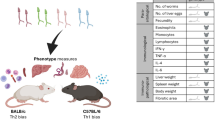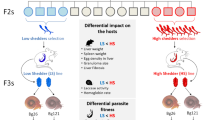Abstract
Echinostoma population regulation in the experimental rodent host is governed by the capacity of the latter to express an effective regulatory response. Parasite establishment, survival and fecundity are affected by host-related factors such as species, strain and age and by parasite-related factors such as species, age and the burden of infection. The genetic heterogeneity in the regulatory response to infection is marked. The most intensively studied host/echinostome combinations compriseE. caproni andE. trivolvis in the mouse host, for which a range of interesting host-parasite relationships has been demonstrated, including concomitant immunity with rapid expulsion of superimposed infections, a long-lasting resistance to secondary infection, a negatively dose-dependent pattern of expulsion of primary infections, a positively dose-dependent reproductive potential, an infective-dose independency of primary worm establishment, and a range of heterologous antagonistic and synergistic interactions in concurrent infections with related and unrelated parasite species. TheEchinostoma/rodent model is highly suitable for studying aspects of parasite population regulation in intestinal trematode infections.
Similar content being viewed by others
References
Barus V, Moravec F, Rysavy B (1974) Antagonistic interaction betweenEchinostoma revolutum andEchinoparyphium recurvatum (Trematoda) in the definitive host. Folia Parasitol (Prague) 21:155–159
Beaver PC (1937) Experimental studies onEchinostoma revolutum (Froelich), a fluke from birds and mammals. Ill Biol Monogr 15:1–96
Bindseil E, Christensen NØ (1984) Thymus-independent crypt hyperplasia and villous atrophy in the small intestine of mice infected with the trematodeEchinostoma revolutum. Parasitology 88:431–438
Christensen NØ (1980)Echinostoma revolutum: labeling of miracidia with radioselenium in vivo and assay for host finding. Exp Parasitol 50:67–73
Christensen NØ, Frandsen F, Roushdy MZ (1980) The influence of environmental conditions and parasite-intermediate host-related factors on the transmission ofEchinostoma liet. Z Parasitenkd 63:47–63
Christensen NØ, Nydal R, Frandsen F, Nasen P (1981a) Homologous immunotolerance and decreased resistance toSchistosoma mansoni inEchinostoma revolutum-infected mice. J Parasitol 67:164–166
Christensen NØ, Nydal R, Frandsen F, Sirag SB, Nansen P (1981b) Further studies on resistance toFasciola hepatica andEchinostoma revolutum in mice infected withSchistosoma sp. Z Parasitenkd 65:293–298
Christensen NØ, Fagbemi BO, Nansen P (1984)Trypanosoma brucei-induced blockage of expulsion ofEchistosoma revolutum and of homologousE. revolutum resistance in mice. J Parasitol 70:558–561
Christensen NØ, Knudsen J, Fagbemi BO, Nansen P (1985) Impairment of primary expulsion ofEchinostoma revolutum in mice concurrently infected withSchistosoma mansoni. J Helminthol 59:333–335
Christensen NØ, Knudsen J, Andreassen J (1986)Echinostoma revolutum: resistance to secondary and superimposed infections in mice. Exp Parasitol 61:311–318
Christensen NØ, Furu P, Kurtzhals J, Odaibo A (1988) Heterologous synergistic interactions in concurrent experimental infection in the mouse withSchistosoma mansoni, Echinostoma revolutum, Plasmodium yoelii, Babesia microti andTrypanosoma brucei. Parasitol Res 74:544–551
Cross JH, Basaca-Sevilla V (1986) Studies onEchinostoma ilocanum in the Phillippines. Southeast Asian J Trop Med Pub Health 17:23–27
Franco J, Huffman JE, Fried B (1986) Infectivity, growth, and development ofEchinostoma revolutum (Digenea: Echinostomatidae) in the golden hamster,Mesocricetums auratus. J Parasitol 72:142–147
Fried B (1985) Maintenance ofEchinostoma revolutum (Trematoda) in the laboratory. Proc P Acad Sci 59:27–28
Fried B, Huffman JE, Franco J (1988) Single- and five-worm infections ofEchinostoma revolutum (Trematoda) in the golden hamster. Int J Parasitol 18:179–181
Hosier DW, Fried B (1986) Infectivity, growth, and distribution ofEchinostoma revolutum in Swiss Webster and ICR mice. Proc Helminthol Soc Wash 53:173–176
Hosier DW, Fried B, Szewczak JP (1988) Homologous and heterologous resistance ofEchinostoma revolutum andE. liei in ICR mice. J Parasitol 74:89–92
Hsu KC, Lie KJ, Basch PF (1968) The life history ofEchinostoma rodriguesi sp. n. (Trematoda: Echinostomatidae). J Parasitol 54:333–339
Huffman JE, Michos C, Fried B (1986) Clinical and pathological effects ofEchinostoma revolutum (Digenea: Echinostomatidae) in the golden hamster,Mesocricetus auratus. Parasitology 93:505–515
Jourdane J, Kulo SD (1981) Etude expérimentale du cycle biologique deEchinostoma togoensis n. sp., parasite l'état larvaire deBiomphalaria pfeifferi au Togo. Ann Parasitol Hum Comp 56:477–488
Kanev I (1985) On the morphology, biology, ecology and taxonomy ofE. revolutum group (Trematoda: Echinostomatidae:Echinostoma). Doctoral Dissertation, University of Sofia, Bulgaria
Lie KJ (1963) The life history ofEchinostoma malayanum Leiper, 1911. Trop Geogr Med 15:17–24
Lie KJ (1964) Studies on Echinostomatidae (Trematoda) in Malaya: VII. The life history ofEchinostoma lindoense Sandground and Bonne, 1940. Trop Georg Med 16:72–81
Lie KJ, Basch PF (1967) The life history ofEchinostoma paraensei sp. n. (Trematoda: Echinostamatidae). J Parasitol 53:1192–1199
Lie KJ, Virik HK (1963) Human infection withEchinostoma malayanum Leiper, 1911 (Trematoda: Echinostomatidae). J Trop Med Hyg 66:77–82
Mohandas A, Nadakal AM (1978) In vivo development ofEchinostoma malayanum Leiper 1911 with notes on effects of population density, chemical composition and pathogenicity and in vitro excystment of the metacercaria (Trematoda: Echinostomatidae). Z Parasitenkd 55:139–151
Odaibo AB, Christensen NØ, Ukoli FMA (1988) Establishment, survival, and fecundity inEchinostoma caproni infections in NMRI mice. Proc Helminthol Soc Wash 55:265–269
Sandground JH, Bonne C (1940)Echinostoma lindoensis n. sp., a new parasite on man in the Celebes with an account of its life history and epidemiology. Am J Trop Med 20:511–535
Senger CM (1954) Notes on the growth, development and survival of two echinostome trematodes. Exp Parasitol 6:491–496
Simonsen PE, Andersen BJ (1986)Echinostoma revolutum in mice: dynamics of the antibody attack to the surface of an intestinal trematode. Int J Parasitol 16:475–482
Sirag SB, Christensen NØ, Frandsen F, Monrad J, Nansen P (1980) Homologous and heterologous resistance inEchinostoma revolutum infections in mice. Parasitology 80:479–486
Thorndyke M, Whitfield PJ (1987) Vasoactive intestinal polypeptide immunoreactive tegumental cells in the digeneanEchinostoma liei: possible role in host-parasite interactions. Gen Comp Endocrinol 68:202–207
Author information
Authors and Affiliations
Rights and permissions
About this article
Cite this article
Christensen, N.Ø., Odaibo, A.B. & Simonsen, P.E. Echinostoma population regulation in experimental rodent definitive hosts. Parasitol Res 75, 83–87 (1988). https://doi.org/10.1007/BF00932705
Accepted:
Issue Date:
DOI: https://doi.org/10.1007/BF00932705




